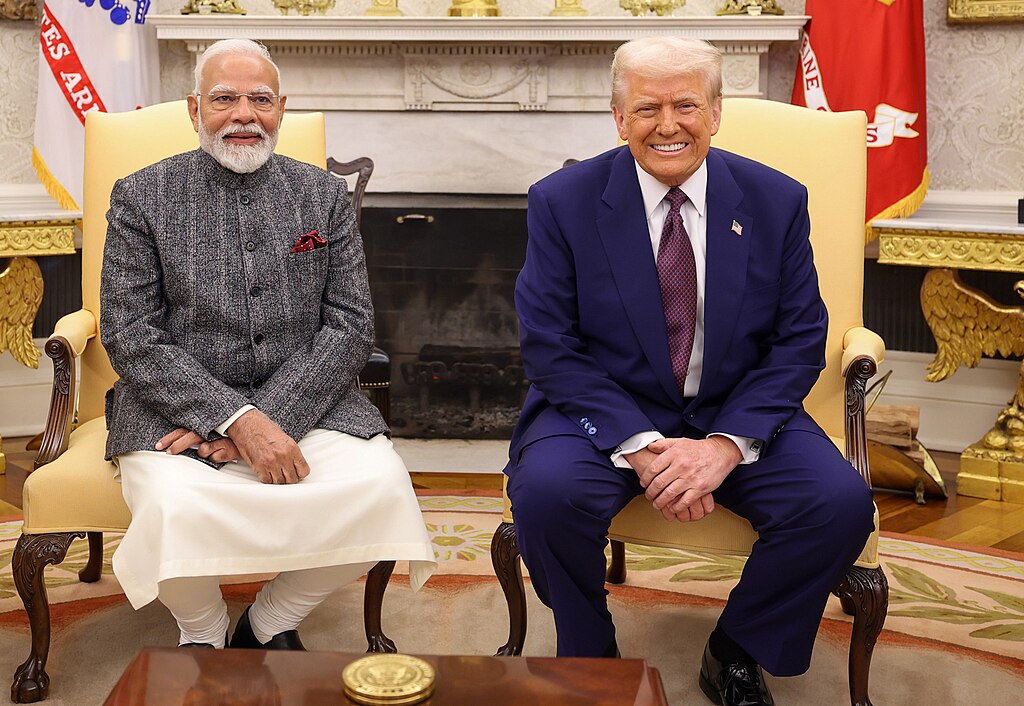U.S. President Donald Trump and Indian Prime Minister Narendra Modi met at the White House to discuss trade, tariffs, and defense agreements. Modi pledged to ease tariffs, increase U.S. oil and gas imports, and purchase more defense equipment, including fighter jets. Trump highlighted India’s interest in acquiring F-35 stealth fighters, Lockheed Martin’s top revenue-generating aircraft, as part of strengthening bilateral ties.
Despite Modi’s commitments, Trump criticized India’s high tariffs, vowing reciprocal measures. Both leaders agreed to trade negotiations, with a U.S. official suggesting a deal could be finalized within the year. Trump also emphasized India’s role in countering China’s influence in the Indo-Pacific region and deepening cooperation in artificial intelligence, nuclear energy, and security.
The meeting also covered immigration policies, with Trump seeking India’s support in addressing unauthorized immigration. Modi’s engagements included a discussion with Elon Musk, potentially regarding Starlink’s entry into the Indian market, and a meeting with Tulsi Gabbard, where counter-terrorism and cybersecurity were key topics.
India’s trade deficit with the U.S. stands at $45.6 billion, with its average tariff rate significantly higher than that of the U.S. While both nations aim for stronger ties, trade disputes remain a sticking point. Trump acknowledged India’s strategic importance, particularly in dealing with China and Russia. However, concerns remain over India’s continued economic ties with Russia amid the Ukraine conflict.
The leaders expressed optimism about resolving trade tensions, but experts predict ongoing challenges. As India seeks to double trade with the U.S. by 2030, negotiations will play a crucial role in shaping economic and geopolitical relations between the two countries.



 Marco Rubio’s Plane Faces Mechanical Issue, Returns to Washington
Marco Rubio’s Plane Faces Mechanical Issue, Returns to Washington  Trump Orders Study on Abortion Pill Safety, Decision on Restrictions Pending
Trump Orders Study on Abortion Pill Safety, Decision on Restrictions Pending  Macron Urges Ukraine-Russia Peace Talks, Cautions Against Trump’s Quick Deal
Macron Urges Ukraine-Russia Peace Talks, Cautions Against Trump’s Quick Deal  Justice Department Shakeup: Prosecutors Resign Over Political Pressure
Justice Department Shakeup: Prosecutors Resign Over Political Pressure  China Accuses Australia of Provocation in South China Sea Dispute
China Accuses Australia of Provocation in South China Sea Dispute  China Urges Philippines to Withdraw U.S. Typhon Missile System Amid Rising Tensions
China Urges Philippines to Withdraw U.S. Typhon Missile System Amid Rising Tensions  Zelenskiy Condemns Russian Drone Strike on Chornobyl Nuclear Shelter
Zelenskiy Condemns Russian Drone Strike on Chornobyl Nuclear Shelter  Trump Considers Extending TikTok Ban Deadline but Hopes for U.S. Deal
Trump Considers Extending TikTok Ban Deadline but Hopes for U.S. Deal  Trump and Modi to Hold Rare Joint Press Conference in Washington
Trump and Modi to Hold Rare Joint Press Conference in Washington  Trump Signs Executive Order on Reciprocal Tariffs, Delays Immediate Implementation
Trump Signs Executive Order on Reciprocal Tariffs, Delays Immediate Implementation  Rubio, Trump Push for Bold Diplomacy in Russia-Ukraine Conflict
Rubio, Trump Push for Bold Diplomacy in Russia-Ukraine Conflict  DOJ Sues New York Over Immigration Law, Citing Federal Supremacy
DOJ Sues New York Over Immigration Law, Citing Federal Supremacy  Brazil Criticizes U.S. Tariff Plan on Ethanol Trade
Brazil Criticizes U.S. Tariff Plan on Ethanol Trade  Elon Musk Faces Legal Battle Over Federal Spending Cuts Under Trump
Elon Musk Faces Legal Battle Over Federal Spending Cuts Under Trump  Danielle Sassoon Quits as U.S. Attorney, Defies Trump Administration Over Eric Adams Case
Danielle Sassoon Quits as U.S. Attorney, Defies Trump Administration Over Eric Adams Case  Federal Officials Challenge Trump's Firings Amid Mass Layoffs
Federal Officials Challenge Trump's Firings Amid Mass Layoffs  US to Boost Military Sales to India, Including F-35 Jets, Starting 2025
US to Boost Military Sales to India, Including F-35 Jets, Starting 2025 































